Octopus v4: Graph of language models

Language models have been effective in a wide range of applications, yet the most sophisticated models are often proprietary. For example, GPT-4 by OpenAI and various models by Anthropic are expensive and consume substantial energy. In contrast, the open-source community has produced competitive models, like Llama3. Furthermore, niche-specific smaller language models, such as those tailored for legal, medical or financial tasks, have outperformed their proprietary counterparts. This paper introduces a novel approach that employs \textit{functional tokens} to integrate \textbf{multiple open-source models}, each optimized for particular tasks. Our newly developed Octopus v4 model leverages \textit{functional tokens} to intelligently direct user queries to the most appropriate vertical model and reformat the query to achieve the best performance. Octopus v4, an evolution of the Octopus v1, v2, and v3 models, excels in selection and parameter understanding and reformatting. Additionally, we explore the use of graph as a versatile data structure that effectively coordinates multiple open-source models by harnessing the capabilities of the Octopus model and \textit{functional tokens}. Use our open-sourced GitHub (\url{https://www.nexa4ai.com/}) to try Octopus v4 models (\url{https://huggingface.co/NexaAIDev/Octopus-v4}), and contrite to a larger graph of language models. By activating models less than 10B parameters, we achieved SOTA MMLU score of 74.8 among the same level models.
InstantFamily: Masked Attention for Zero-shot Multi-ID Image Generation
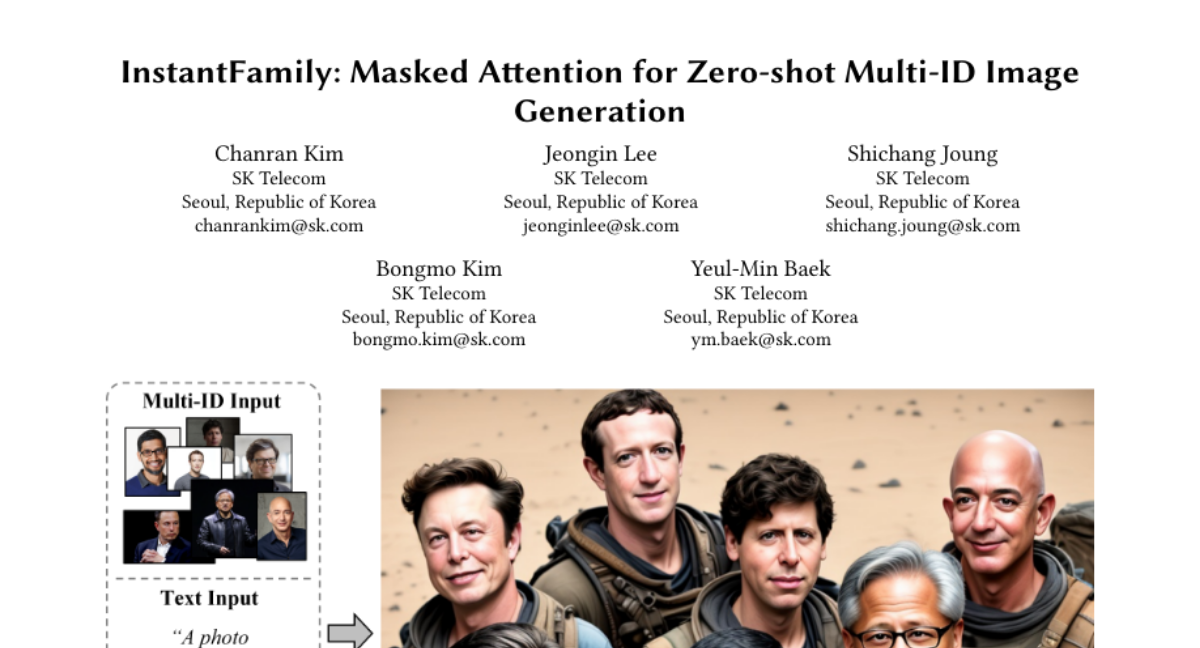
In the field of personalized image generation, the ability to create images preserving concepts has significantly improved. Creating an image that naturally integrates multiple concepts in a cohesive and visually appealing composition can indeed be challenging. This paper introduces "InstantFamily," an approach that employs a novel masked cross-attention mechanism and a multimodal embedding stack to achieve zero-shot multi-ID image generation. Our method effectively preserves ID as it utilizes global and local features from a pre-trained face recognition model integrated with text conditions. Additionally, our masked cross-attention mechanism enables the precise control of multi-ID and composition in the generated images. We demonstrate the effectiveness of InstantFamily through experiments showing its dominance in generating images with multi-ID, while resolving well-known multi-ID generation problems. Additionally, our model achieves state-of-the-art performance in both single-ID and multi-ID preservation. Furthermore, our model exhibits remarkable scalability with a greater number of ID preservation than it was originally trained with.
Better & Faster Large Language Models via Multi-token Prediction
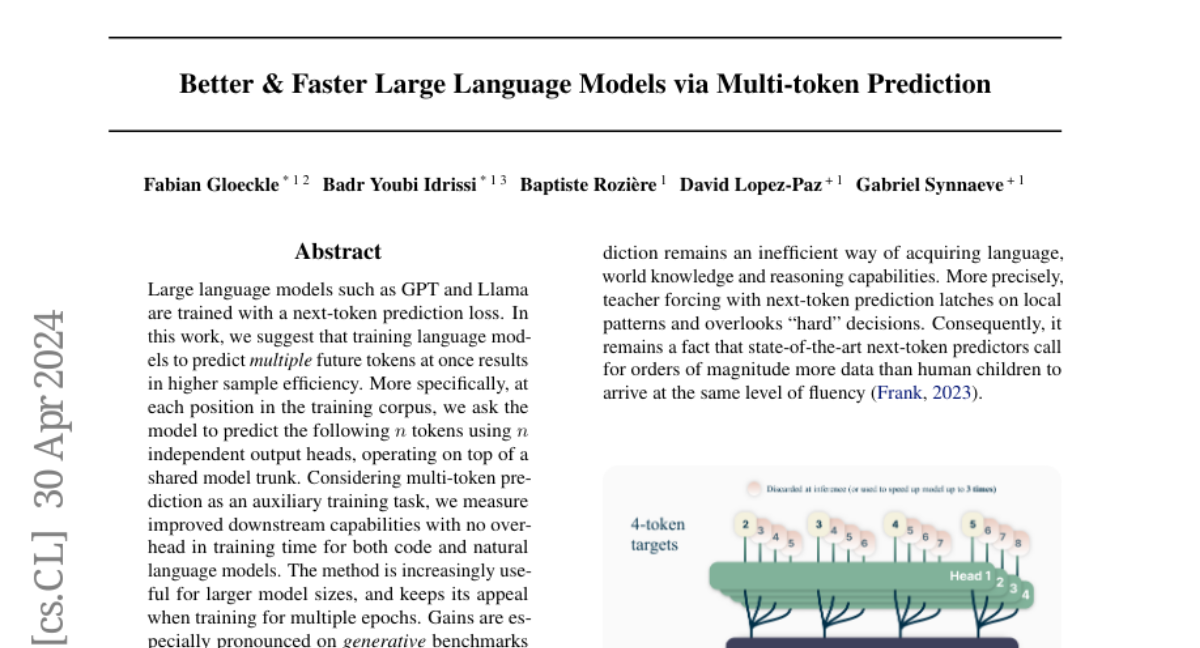
Large language models such as GPT and Llama are trained with a next-token prediction loss. In this work, we suggest that training language models to predict multiple future tokens at once results in higher sample efficiency. More specifically, at each position in the training corpus, we ask the model to predict the following n tokens using n independent output heads, operating on top of a shared model trunk. Considering multi-token prediction as an auxiliary training task, we measure improved downstream capabilities with no overhead in training time for both code and natural language models. The method is increasingly useful for larger model sizes, and keeps its appeal when training for multiple epochs. Gains are especially pronounced on generative benchmarks like coding, where our models consistently outperform strong baselines by several percentage points. Our 13B parameter models solves 12 % more problems on HumanEval and 17 % more on MBPP than comparable next-token models. Experiments on small algorithmic tasks demonstrate that multi-token prediction is favorable for the development of induction heads and algorithmic reasoning capabilities. As an additional benefit, models trained with 4-token prediction are up to 3 times faster at inference, even with large batch sizes.
GS-LRM: Large Reconstruction Model for 3D Gaussian Splatting

We propose GS-LRM, a scalable large reconstruction model that can predict high-quality 3D Gaussian primitives from 2-4 posed sparse images in 0.23 seconds on single A100 GPU. Our model features a very simple transformer-based architecture; we patchify input posed images, pass the concatenated multi-view image tokens through a sequence of transformer blocks, and decode final per-pixel Gaussian parameters directly from these tokens for differentiable rendering. In contrast to previous LRMs that can only reconstruct objects, by predicting per-pixel Gaussians, GS-LRM naturally handles scenes with large variations in scale and complexity. We show that our model can work on both object and scene captures by training it on Objaverse and RealEstate10K respectively. In both scenarios, the models outperform state-of-the-art baselines by a wide margin. We also demonstrate applications of our model in downstream 3D generation tasks. Our project webpage is available at: https://sai-bi.github.io/project/gs-lrm/ .
Visual Fact Checker: Enabling High-Fidelity Detailed Caption Generation

Existing automatic captioning methods for visual content face challenges such as lack of detail, content hallucination, and poor instruction following. In this work, we propose VisualFactChecker (VFC), a flexible training-free pipeline that generates high-fidelity and detailed captions for both 2D images and 3D objects. VFC consists of three steps: 1) proposal, where image-to-text captioning models propose multiple initial captions; 2) verification, where a large language model (LLM) utilizes tools such as object detection and VQA models to fact-check proposed captions; 3) captioning, where an LLM generates the final caption by summarizing caption proposals and the fact check verification results. In this step, VFC can flexibly generate captions in various styles following complex instructions. We conduct comprehensive captioning evaluations using four metrics: 1) CLIP-Score for image-text similarity; 2) CLIP-Image-Score for measuring the image-image similarity between the original and the reconstructed image generated by a text-to-image model using the caption. 3) human study on Amazon Mechanical Turk; 4) GPT-4V for fine-grained evaluation. Evaluation results show that VFC outperforms state-of-the-art open-sourced captioning methods for 2D images on the COCO dataset and 3D assets on the Objaverse dataset. Our study demonstrates that by combining open-source models into a pipeline, we can attain captioning capability comparable to proprietary models such as GPT-4V, despite being over 10x smaller in model size.
Iterative Reasoning Preference Optimization
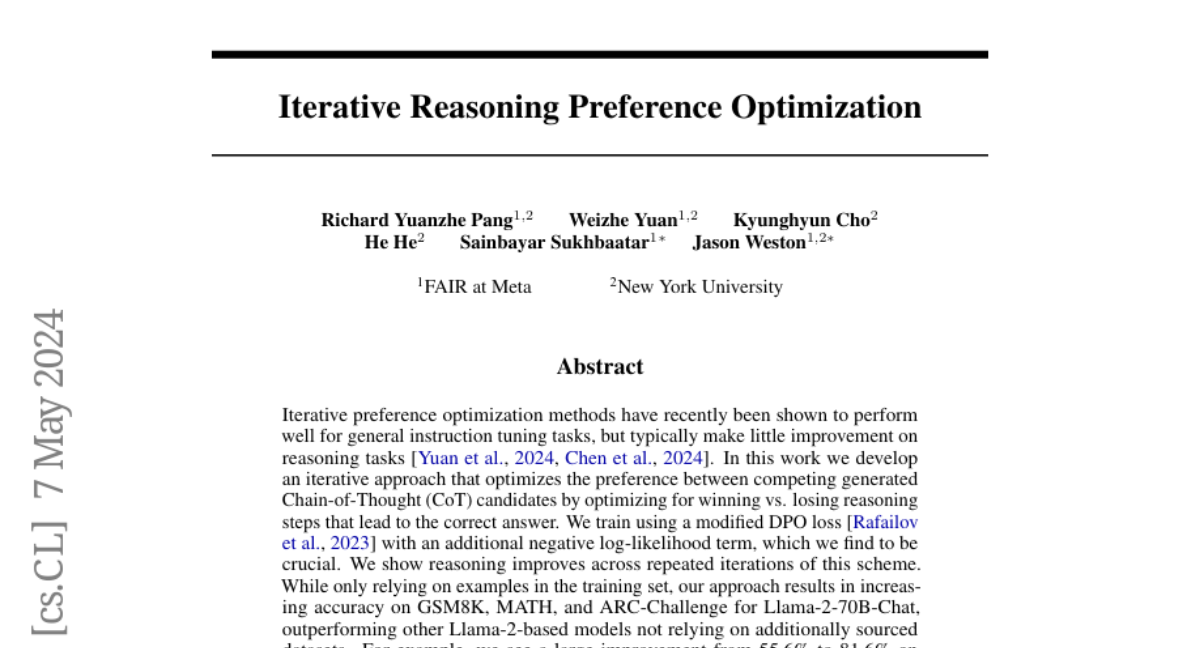
Iterative preference optimization methods have recently been shown to perform well for general instruction tuning tasks, but typically make little improvement on reasoning tasks (Yuan et al., 2024, Chen et al., 2024). In this work we develop an iterative approach that optimizes the preference between competing generated Chain-of-Thought (CoT) candidates by optimizing for winning vs. losing reasoning steps that lead to the correct answer. We train using a modified DPO loss (Rafailov et al., 2023) with an additional negative log-likelihood term, which we find to be crucial. We show reasoning improves across repeated iterations of this scheme. While only relying on examples in the training set, our approach results in increasing accuracy for Llama-2-70B-Chat from 55.6% to 81.6% on GSM8K (and 88.7% with majority voting out of 32 samples), from 12.5% to 20.8% on MATH, and from 77.8% to 86.7% on ARC-Challenge, which outperforms other Llama-2-based models not relying on additionally sourced datasets.
SAGS: Structure-Aware 3D Gaussian Splatting
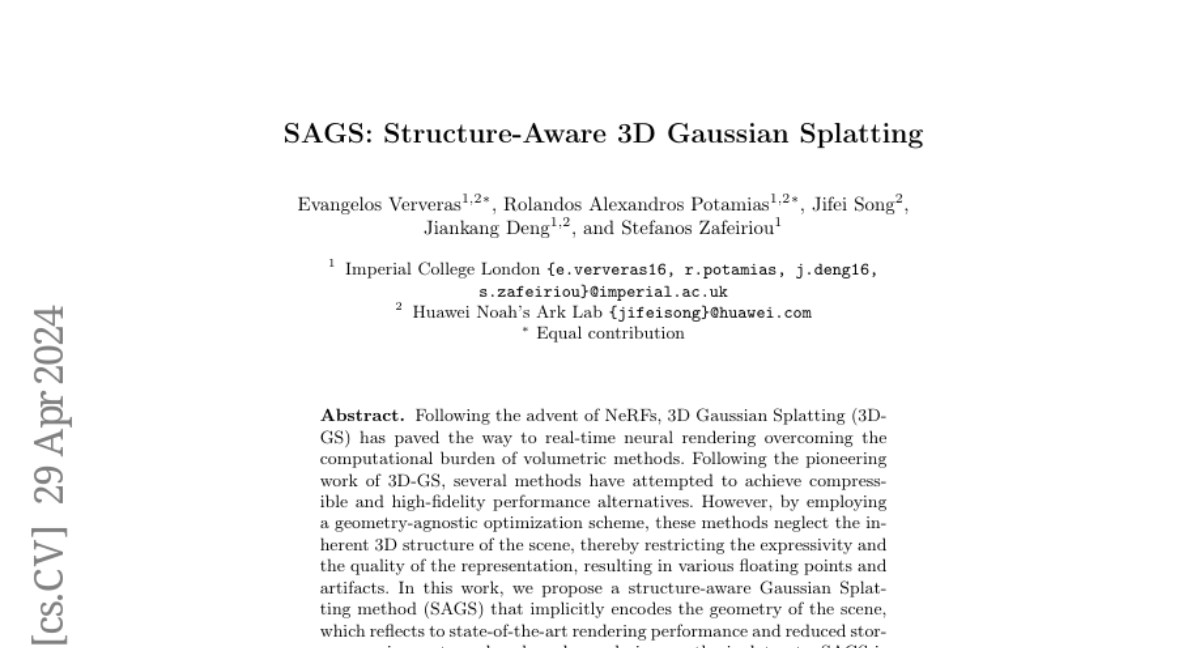
Following the advent of NeRFs, 3D Gaussian Splatting (3D-GS) has paved the way to real-time neural rendering overcoming the computational burden of volumetric methods. Following the pioneering work of 3D-GS, several methods have attempted to achieve compressible and high-fidelity performance alternatives. However, by employing a geometry-agnostic optimization scheme, these methods neglect the inherent 3D structure of the scene, thereby restricting the expressivity and the quality of the representation, resulting in various floating points and artifacts. In this work, we propose a structure-aware Gaussian Splatting method (SAGS) that implicitly encodes the geometry of the scene, which reflects to state-of-the-art rendering performance and reduced storage requirements on benchmark novel-view synthesis datasets. SAGS is founded on a local-global graph representation that facilitates the learning of complex scenes and enforces meaningful point displacements that preserve the scene's geometry. Additionally, we introduce a lightweight version of SAGS, using a simple yet effective mid-point interpolation scheme, which showcases a compact representation of the scene with up to 24$\times$ size reduction without the reliance on any compression strategies. Extensive experiments across multiple benchmark datasets demonstrate the superiority of SAGS compared to state-of-the-art 3D-GS methods under both rendering quality and model size. Besides, we demonstrate that our structure-aware method can effectively mitigate floating artifacts and irregular distortions of previous methods while obtaining precise depth maps. Project page https://eververas.github.io/SAGS/.
DOCCI: Descriptions of Connected and Contrasting Images
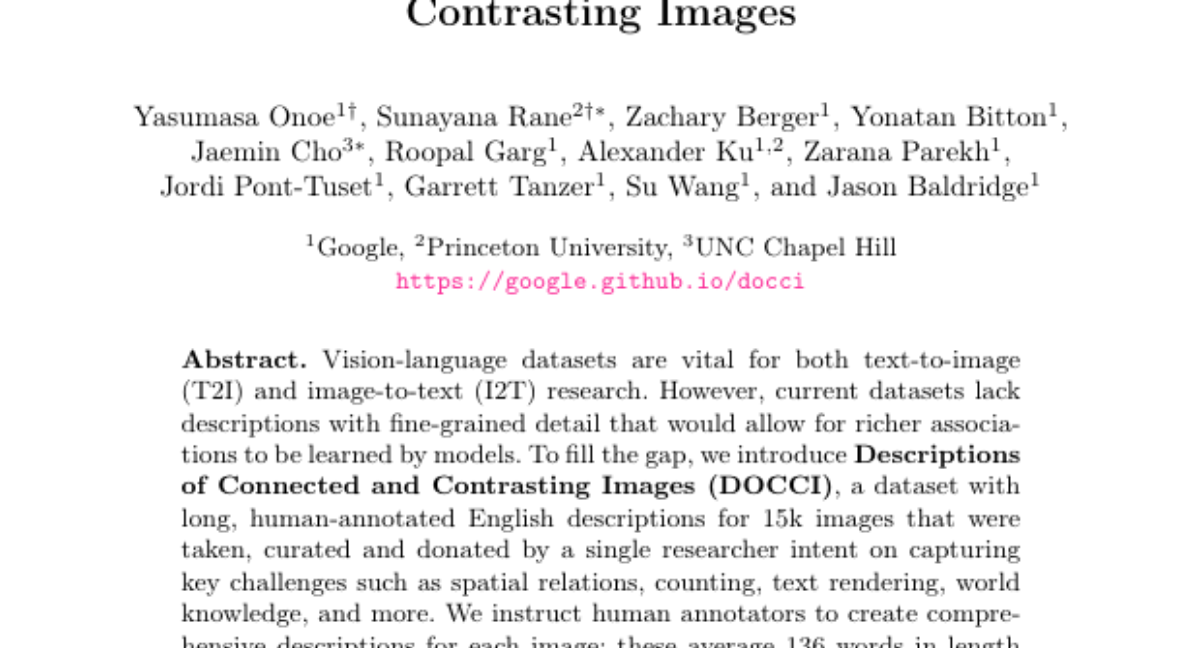
Vision-language datasets are vital for both text-to-image (T2I) and image-to-text (I2T) research. However, current datasets lack descriptions with fine-grained detail that would allow for richer associations to be learned by models. To fill the gap, we introduce Descriptions of Connected and Contrasting Images (DOCCI), a dataset with long, human-annotated English descriptions for 15k images that were taken, curated and donated by a single researcher intent on capturing key challenges such as spatial relations, counting, text rendering, world knowledge, and more. We instruct human annotators to create comprehensive descriptions for each image; these average 136 words in length and are crafted to clearly distinguish each image from those that are related or similar. Each description is highly compositional and typically encompasses multiple challenges. Through both quantitative and qualitative analyses, we demonstrate that DOCCI serves as an effective training resource for image-to-text generation -- a PaLI 5B model finetuned on DOCCI shows equal or superior results compared to highly-performant larger models like LLaVA-1.5 7B and InstructBLIP 7B. Furthermore, we show that DOCCI is a useful testbed for text-to-image generation, highlighting the limitations of current text-to-image models in capturing long descriptions and fine details.
Invisible Stitch: Generating Smooth 3D Scenes with Depth Inpainting

3D scene generation has quickly become a challenging new research direction, fueled by consistent improvements of 2D generative diffusion models. Most prior work in this area generates scenes by iteratively stitching newly generated frames with existing geometry. These works often depend on pre-trained monocular depth estimators to lift the generated images into 3D, fusing them with the existing scene representation. These approaches are then often evaluated via a text metric, measuring the similarity between the generated images and a given text prompt. In this work, we make two fundamental contributions to the field of 3D scene generation. First, we note that lifting images to 3D with a monocular depth estimation model is suboptimal as it ignores the geometry of the existing scene. We thus introduce a novel depth completion model, trained via teacher distillation and self-training to learn the 3D fusion process, resulting in improved geometric coherence of the scene. Second, we introduce a new benchmarking scheme for scene generation methods that is based on ground truth geometry, and thus measures the quality of the structure of the scene.
Extending Llama-3's Context Ten-Fold Overnight
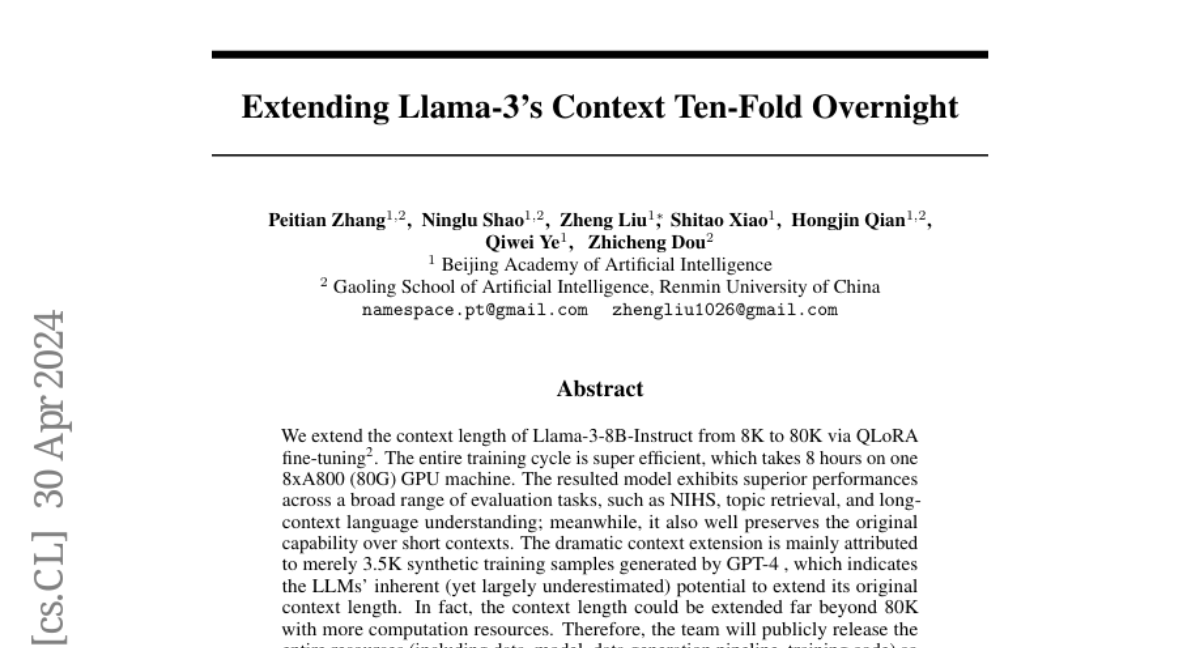
We extend the context length of Llama-3-8B-Instruct from 8K to 80K via QLoRA fine-tuning. The entire training cycle is super efficient, which takes 8 hours on one 8xA800 (80G) GPU machine. The resulted model exhibits superior performances across a broad range of evaluation tasks, such as NIHS, topic retrieval, and long-context language understanding; meanwhile, it also well preserves the original capability over short contexts. The dramatic context extension is mainly attributed to merely 3.5K synthetic training samples generated by GPT-4 , which indicates the LLMs' inherent (yet largely underestimated) potential to extend its original context length. In fact, the context length could be extended far beyond 80K with more computation resources. Therefore, the team will publicly release the entire resources (including data, model, data generation pipeline, training code) so as to facilitate the future research from the community: \url{https://github.com/FlagOpen/FlagEmbedding}.
Lightplane: Highly-Scalable Components for Neural 3D Fields

Contemporary 3D research, particularly in reconstruction and generation, heavily relies on 2D images for inputs or supervision. However, current designs for these 2D-3D mapping are memory-intensive, posing a significant bottleneck for existing methods and hindering new applications. In response, we propose a pair of highly scalable components for 3D neural fields: Lightplane Render and Splatter, which significantly reduce memory usage in 2D-3D mapping. These innovations enable the processing of vastly more and higher resolution images with small memory and computational costs. We demonstrate their utility in various applications, from benefiting single-scene optimization with image-level losses to realizing a versatile pipeline for dramatically scaling 3D reconstruction and generation. Code: \url{https://github.com/facebookresearch/lightplane}.
MotionLCM: Real-time Controllable Motion Generation via Latent Consistency Model

This work introduces MotionLCM, extending controllable motion generation to a real-time level. Existing methods for spatial control in text-conditioned motion generation suffer from significant runtime inefficiency. To address this issue, we first propose the motion latent consistency model (MotionLCM) for motion generation, building upon the latent diffusion model (MLD). By employing one-step (or few-step) inference, we further improve the runtime efficiency of the motion latent diffusion model for motion generation. To ensure effective controllability, we incorporate a motion ControlNet within the latent space of MotionLCM and enable explicit control signals (e.g., pelvis trajectory) in the vanilla motion space to control the generation process directly, similar to controlling other latent-free diffusion models for motion generation. By employing these techniques, our approach can generate human motions with text and control signals in real-time. Experimental results demonstrate the remarkable generation and controlling capabilities of MotionLCM while maintaining real-time runtime efficiency.
KAN: Kolmogorov-Arnold Networks
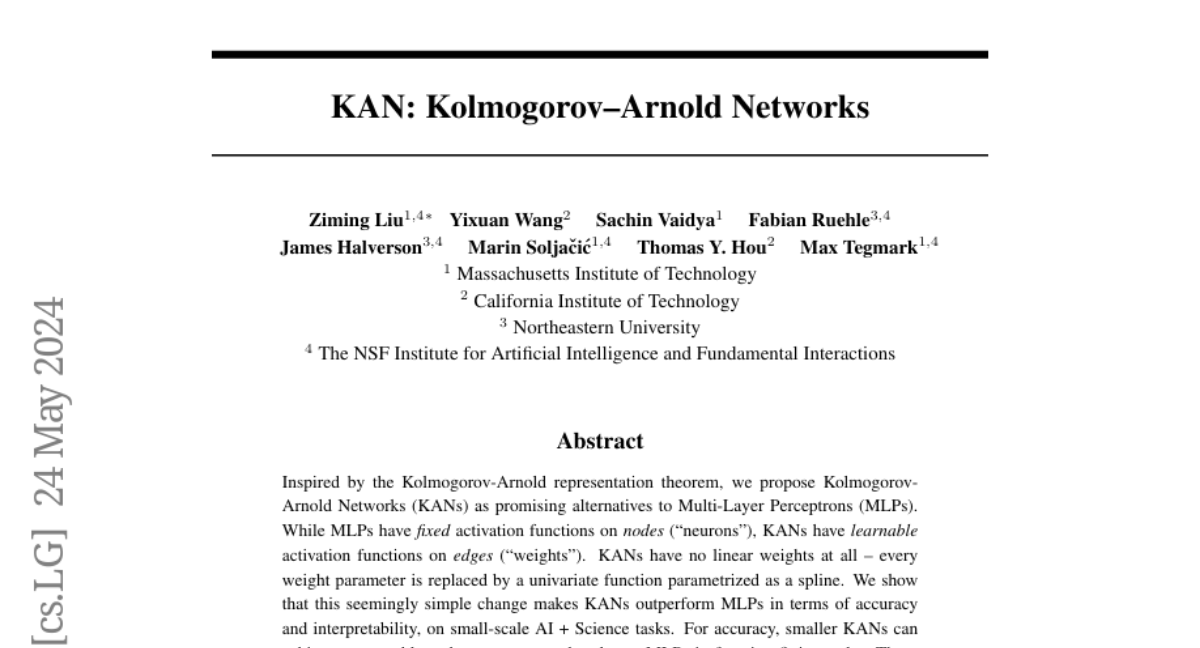
Inspired by the Kolmogorov-Arnold representation theorem, we propose Kolmogorov-Arnold Networks (KANs) as promising alternatives to Multi-Layer Perceptrons (MLPs). While MLPs have fixed activation functions on nodes ("neurons"), KANs have learnable activation functions on edges ("weights"). KANs have no linear weights at all -- every weight parameter is replaced by a univariate function parametrized as a spline. We show that this seemingly simple change makes KANs outperform MLPs in terms of accuracy and interpretability. For accuracy, much smaller KANs can achieve comparable or better accuracy than much larger MLPs in data fitting and PDE solving. Theoretically and empirically, KANs possess faster neural scaling laws than MLPs. For interpretability, KANs can be intuitively visualized and can easily interact with human users. Through two examples in mathematics and physics, KANs are shown to be useful collaborators helping scientists (re)discover mathematical and physical laws. In summary, KANs are promising alternatives for MLPs, opening opportunities for further improving today's deep learning models which rely heavily on MLPs.
MicroDreamer: Zero-shot 3D Generation in $\sim$20 Seconds by Score-based Iterative Reconstruction

Optimization-based approaches, such as score distillation sampling (SDS), show promise in zero-shot 3D generation but suffer from low efficiency, primarily due to the high number of function evaluations (NFEs) required for each sample. In this paper, we introduce score-based iterative reconstruction (SIR), an efficient and general algorithm for 3D generation with a multi-view score-based diffusion model. Given the images produced by the diffusion model, SIR reduces NFEs by repeatedly optimizing 3D parameters, unlike the single optimization in SDS, mimicking the 3D reconstruction process. With other improvements including optimization in the pixel space, we present an efficient approach called MicroDreamer that generally applies to various 3D representations and 3D generation tasks. In particular, retaining a comparable performance, MicroDreamer is 5-20 times faster than SDS in generating neural radiance field and takes about 20 seconds to generate meshes from 3D Gaussian splitting on a single A100 GPU, halving the time of the fastest zero-shot baseline, DreamGaussian. Our code is available at https://github.com/ML-GSAI/MicroDreamer.